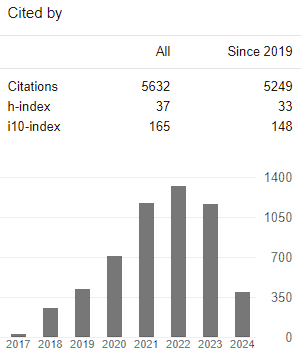The The children character improvement through painting activities in art school: I Wayan Gama Painting School
Keywords:
character education, discipline, honesty, painting creativity, respect for othersAbstract
The present study was intended to study the process of children character improving through painting activities, in an art school namely "I Wayan Gama Painting School" in Desa Keliki, Tegallalang Sub-District, Gianyar Regency, Bali Province. In term of this was interesting due to in the midst of the various economic activities done by their parents in the family, it was occurred the children character education to be neglected. It was influenced the character education in their schools at Indonesia was not taught explicitly design, unlike a single subject, however, it was given an integrated way through religious education, goodness, nationality, therefore the character Improving through artistic creativity in art school “I Wayan Gama Painting School” become a very interesting issue to be studied.
Downloads
References
Abdullah, I. (2014). Sociology of Individual Education, Society, and Education. Jakarta: Rajawali Pers.
Adisusilo, J. R. (2013). Sutarjo, Sejarah Pemikiran Barat dari Klasik sampai yang Modern.
Azwar, S. (2007). Sikap manusia. Teori dan Pengukurannya, Pustaka Pelajar, Yogyakarta.
Baharuddin & Wahyuni, E. N. (2010). Teori belajar & pembelajaran.
Bogdan, R., & Taylor, S. J. (1993). Kualitatif Dasar-dasar penelitian. Surabaya: Usaha Nasional.
Gagnon, G. W., & Collay, M. (2001). Designing for learning: Six elements in constructivist classrooms. Corwin Press.
Goleman, D. (2003). What makes a leader. Organizational influence processes, 229-241.
Hassan, F. (2004). Cultural diversity and the prospect of peacebuilding through sharing a we-world. In Ongoing Themes in Psychology and Culture. Selected Papers from the Sixteenth International Congress of the International Association for Cross-Cultural Psychology. International Association for Cross-Cultural Psychology.
Henselin, J.M. (2007). Sociology with Earthed Approach. Volume I (translation). Jakarta: Erlangga.
Kesuma, D., Triatna, C., & Permana, J. (2011). Pendidikan karakter. Bandung: PT Remaja Rosdakarya.
Lickona, T. (2009). Educating for character: How our schools can teach respect and responsibility. Bantam.
Lincoln, Y., & Guba, E. G. (1985). Lincoln, Yvonne, and Egon G. Guba, Naturalistic Inquiry. Beverly Hills, CA: Sage, 1985.
Manan, I. (1989). Dasar-Dasar Sosial Budaya Pendidikan. Jakarta: Departemen Pendidikan dan Kebudayaan, Direktorat Jenderal Pendidikan Tinggi, Proyek Pengembangan Lembaga Pendidikan Tenaga Kependidikan.
Miles, M. B. (1994). dan Huberman, AM (1992). Qualitative Data Analysis.
Moleong, L. J. (1999). Metodologi penelitian. Bandung: PT. Remaja Rosda Karya.
Pendidikan, D., Dasar, K. D. J. P., & Kesiswaan, M. D. P. (1995). Informasi tentang Organisasi Siswa Intra Sekolah (OSIS).
Saebani, A. A., & Afifuddin, H. (2009). Metodologi penelitian kualitatif. Bandung: CV. Pustaka Setia.
Soeprapto, S. (2003). Metode Ilmiah dalam Tim Dosen Filsafat Ilmu Fakultas Filsafat UGM. Filsafat Ilmu Sebagai Dasar Pengembangan Ilmu Pengetahuan.
Sugiono (2011). Educational Research Methods Quantitative Approach, Qualitative, and R & D. Bandung Alfabeta.
Suyata. (1987). Educational experience perceived by general secondary school students and their cognitive styles among three Indonesian ethnic groups in Bali and Yogyakarta: Balinese, Chinese and Javanese (Doctoral dissertation).
Zubaedi. (2011). Character Education Design, Conception and Application in Educational Institutions. Jakarta: Kencana.
Published
How to Cite
Issue
Section
Articles published in the International Research Journal of Management, IT and Social sciences (IRJMIS) are available under Creative Commons Attribution Non-Commercial No Derivatives Licence (CC BY-NC-ND 4.0). Authors retain copyright in their work and grant IRJMIS right of first publication under CC BY-NC-ND 4.0. Users have the right to read, download, copy, distribute, print, search, or link to the full texts of articles in this journal, and to use them for any other lawful purpose.
Articles published in IRJMIS can be copied, communicated and shared in their published form for non-commercial purposes provided full attribution is given to the author and the journal. Authors are able to enter into separate, additional contractual arrangements for the non-exclusive distribution of the journal's published version of the work (e.g., post it to an institutional repository or publish it in a book), with an acknowledgment of its initial publication in this journal.
This copyright notice applies to articles published in IRJMIS volumes 7 onwards. Please read about the copyright notices for previous volumes under Journal History.













